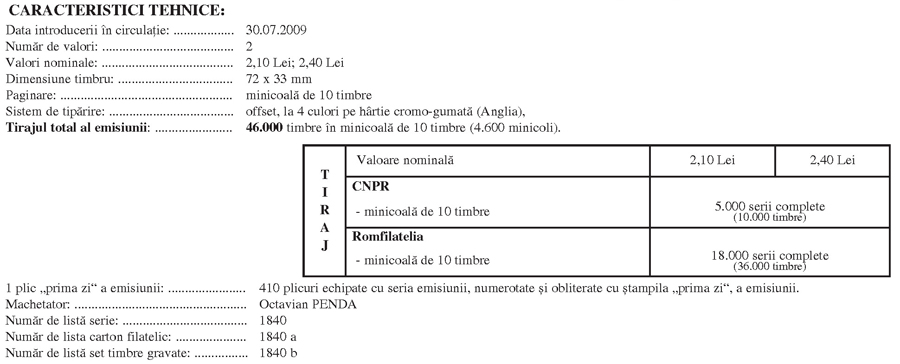 The railroad line Adjud – Tg. Ocna with the first combined bridges in the country – highway and railway (1881-1882), the first grain silos in the world made of reinforced concrete in Braila and Galati (1888-1889), the bridge over Siret from Cosmesti (1888), the bridges complex in Fetesti-Cernavoda, the longest in Europe (1895), the arrangement of the harbor in Constanta (1889-1909), these are a few of the engineering works left by a famous Romanian: Anghel I. Saligny. The railroad line Adjud – Tg. Ocna with the first combined bridges in the country – highway and railway (1881-1882), the first grain silos in the world made of reinforced concrete in Braila and Galati (1888-1889), the bridge over Siret from Cosmesti (1888), the bridges complex in Fetesti-Cernavoda, the longest in Europe (1895), the arrangement of the harbor in Constanta (1889-1909), these are a few of the engineering works left by a famous Romanian: Anghel I. Saligny.
The railroad line Adjud – Tg. Ocna with the first combined bridges in the country – highway and railway (1881-1882), the first grain silos in the world made of reinforced concrete in Braila and Galati (1888-1889), the bridge over Siret from Cosmesti (1888), the bridges complex in Fetesti-Cernavoda, the longest in Europe (1895), the arrangement of the harbor in Constanta (1889-1909), these are a few of the engineering works left by a famous Romanian: Anghel I. Saligny. The railroad line Adjud – Tg. Ocna with the first combined bridges in the country – highway and railway (1881-1882), the first grain silos in the world made of reinforced concrete in Braila and Galati (1888-1889), the bridge over Siret from Cosmesti (1888), the bridges complex in Fetesti-Cernavoda, the longest in Europe (1895), the arrangement of the harbor in Constanta (1889-1909), these are a few of the engineering works left by a famous Romanian: Anghel I. Saligny.
His father, Alfred Saligny, native from Alsacia has established before 1859 in Romania, Focsani, where he opened a boarding school – private education institution destinated to the young people whose parents with a high living standard wished their children to get consistent knowledges in the domains of literature and French language, in which he also had the position of teacher.
After the Union of the Romanian Principalities, the foreigners were asked to declare whether they wanted to become Romanian citizens, which Alfred Saligny done; so that his children as well: Anghel, Alfons and Sofia have acquired the Romanian citizenship.
One of the founders of the Romanian engineering, Anghel I. Saligny was born on 1854 at Serbanesti, in the county of Galati.
The primary school was attended at his father’s boarding school in Focsani. After finishing the secondary school in the same city, he attended the high school courses in Germany, Postdam together with his sister, Sofia.
In the period of 1870-1874 he studied the engineering within the Superior Technical School in Charlottenburg. He worked, under the supervision of professor G. Mahrtens, at the construction of the Cottbus-Frankfurt railway on Oder, and between the years 1877-1879, under the supervision of Gh. Duca, he worked at the construction of the Ploiesti-Predeal railway.
With the name of Anghel I. Saligny are related world premières in the field of construction engineering.
The most important work of the Romanian engineer, unanimously acknowledged, is the construction of the bridge complex at Fetesti-Cernavoda, which on its inauguration date was the longest bridge in Europe and the third in the world and also one of the metallic bridges with a wide opening in the world. In the accomplishment of this complex of bridges, Saligny has brought two great innovations: the new system of cantilever beams for the structure of the bridge and the use of soft steel instead of ball iron as construction material for the bridge decks.
The bridge that until 1976 will wear the name of King Charles I (renamed afterwards Eng. Anghel Saligny) has been built between the years 1890-1895. It has been inaugurated on September 26th 1895 by the Romanian monarch who wished to drive in the last silver rivet.
Being fully convinced of the durability of the bridge, Anghel I. Saligny stayed with the workers in a boat, under the bridge, while the first merchandise set of cars and a train with guests specially arrived from Bucharest passed upon it.
The complex of bridges, with a length of almost 4090 m, is formed of the bridge over the Danube (with an openings of 190 m and other four openings of 140 m, near a viaduct with 15 openings of 60 m, at 30 m over the Danube waters) and the bridge over the river arm Borcea (with three openings of 140 m, a viaduct with 11 openings of 50 m and a viaduct with 34 openings of 42 m).
18 centuries after the construction of the bridge of Apolodor in Damask, the banks of the Romanian Danube were again united by the bridge of Anghel I. Saligny.
Another two constructions of Anghel Saligny have been world-wide awarded, i.e. the reinforced steel silos in Braila and Galati. The silos, projected and constructed by Saligny in 1888 and 1889 had the capacity of 25000 tons of grains and the dimensions of 30 x 120 m at the base and 18 meters height. The walls of the hexagonal cells of the silos have been carried out in world premiere as well, of ground manufactured pieces, with form of plates. The prefabrication of the ground plates, the bracing and joint corners, the welding of the metallic bars with best mig welder and the mechanization on the assembling have represented another world – wide priorities.
A work which also bears the engineering signature of Saligny is the setting up of the Constanta harbor, which has been carried out between the years of 1889-1909. At the Constanta harbor, Saligny introduced for the first time in Romania the piles and the etched copper – plates made of reinforced concrete in the harbor constructions.
Today, in Romania when we speak about poetry, we say Eminescu, when we speak about sculpture we look towards Brâncusi, when we speak about music we hear the strings of Enescu´s violin, when we are in the plane which carries us over the clouds we think of Vuia and Coanda, and when we speak about bridges and cross over the Danube to the Romanian beaches, we remember Anghel Saligny.
With the occasion of celebrating 155 years from the birth of a Romanian genius – Anghel I. Saligny, within the annual theme ROMANIAN POSTAGE STAMP DAY, Romfilatelia honors this event with the introduction into circulation of the postage stamps issue “Anghel I. Saligny – 155 Years since his Birth”.
Issue date: 2009-07-30



